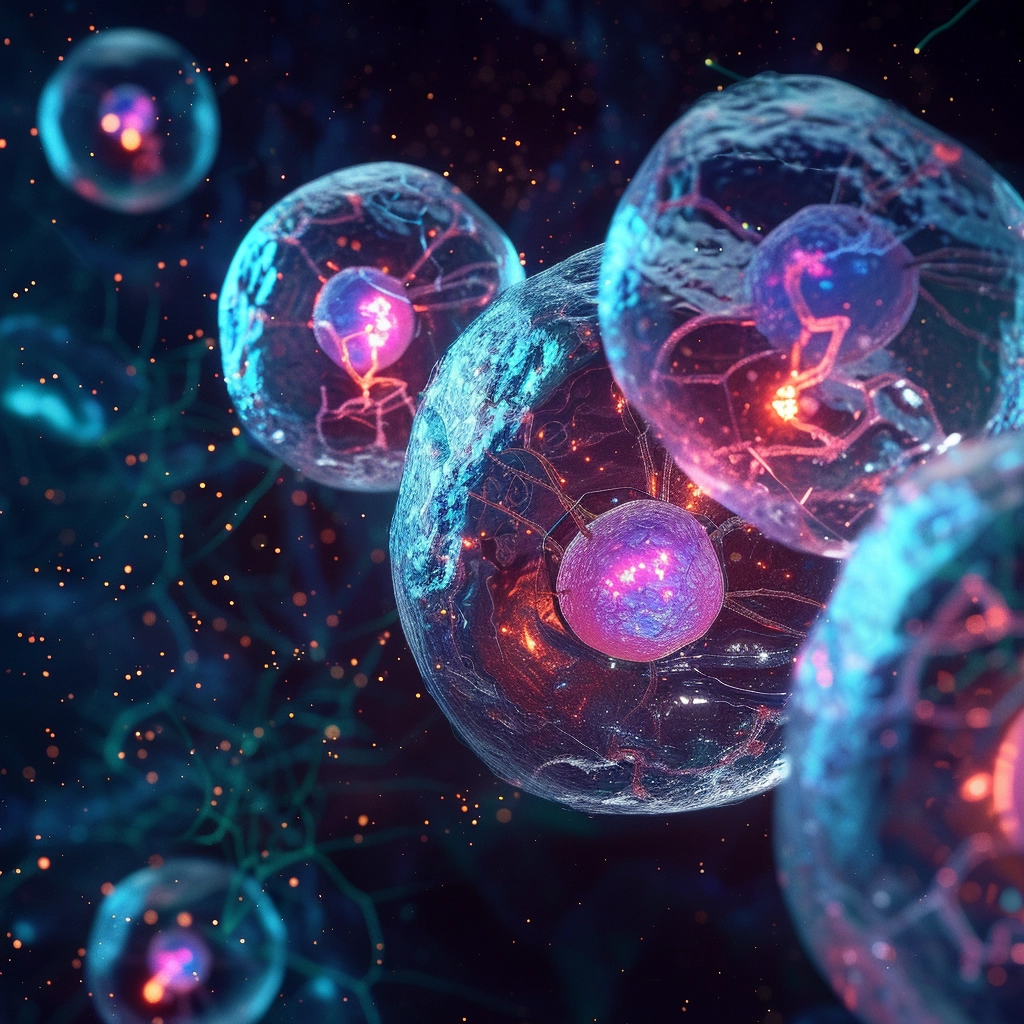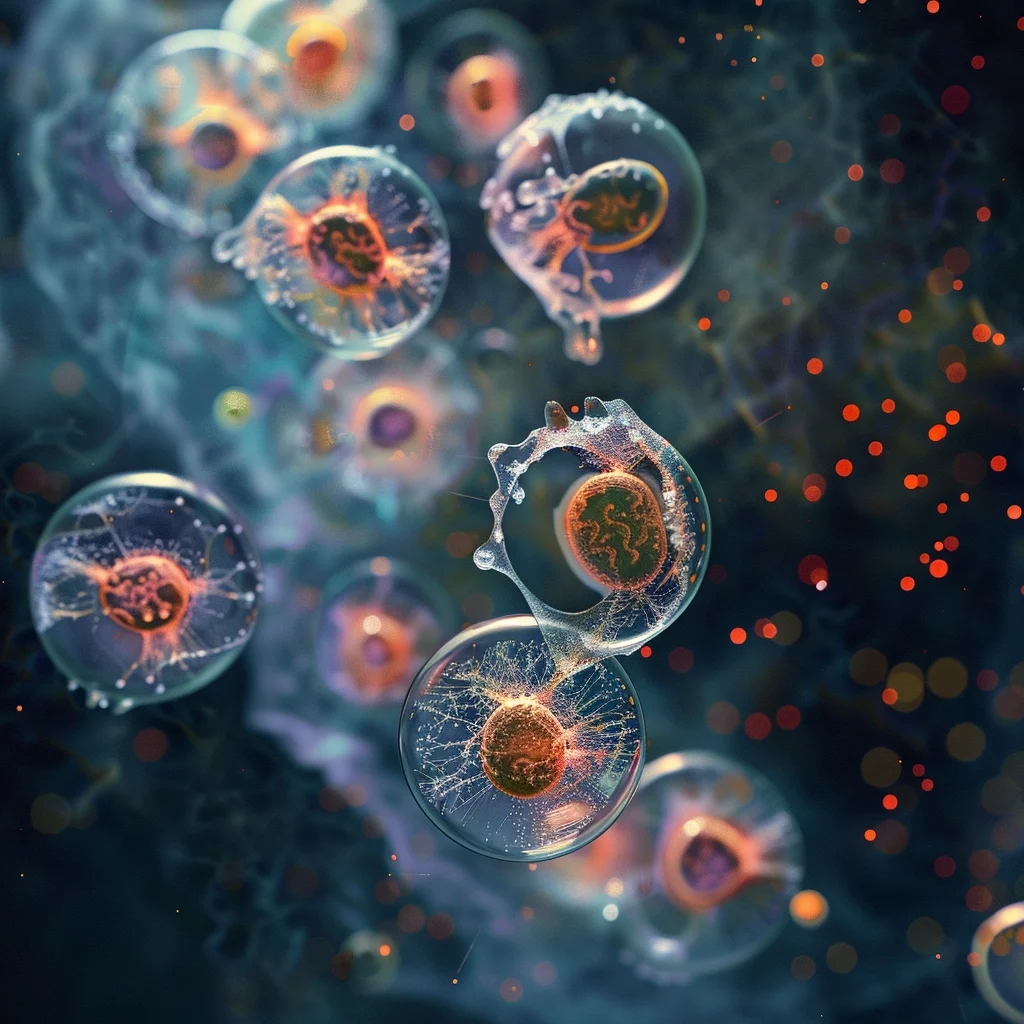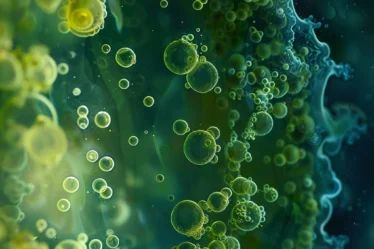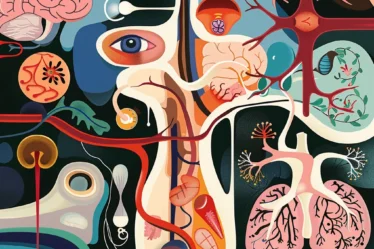
Have you ever wondered how a single cell develops into a complex organism or how our bodies replace billions of cells daily? The secret lies in cell division.
Cell division is a fundamental biological process for life as we know it. It enables organisms to grow, repair damaged structures, and reproduce. Two main types of cell division, mitosis, and meiosis, play crucial roles in these functions. Mitosis is responsible for general growth and repair by producing identical cells, whereas meiosis generates genetic diversity through the production of gametes. Understanding these processes gives us insights into the basics of biology and the continuity of life.
Mitosis, Meiosis and Cell Division: Key Takeaways
In a hurry? Don’t worry. Our critical takeaways on mitosis, meiosis, and cell division will give you a quick and easy summary of the main points:
🟠 Mitosis is essential for cell growth and repair, producing two genetically identical daughter cells through coordinated stages.
🟠 Meiosis generates genetic diversity by producing four unique gametes, crucial for developing species through sexual reproduction.
If you find meiosis and mitosis challenging, don’t worry! Personalized tutoring or interactive biology lessons make these concepts more straightforward. Explore more biology topics and broaden your knowledge with our free Biology blogs.
Exploring Mitosis: The Process of Cellular Reproduction
Mitosis is a form of cell division that is central to life itself. This process is how cells duplicate, creating two identical sets from a single cell. It’s the engine behind your body’s growth and ability to repair wounds. Every time you heal from a cut or grow a bit taller, mitosis is at work behind the scenes.
But mitosis isn’t just a simple split; it’s a detailed, carefully orchestrated sequence of events. It falls within a larger cycle known as the cell cycle, which includes periods of growth, DNA replication, and cell division. The cell cycle is often visualized in stages, with mitosis being one of the final steps. This cycle ensures that each new cell receives a complete set of genetic instructions necessary for survival and function.
Mitosis itself is divided into distinct phases, each with crucial roles:
- Prophase: Chromosomes condense and become visible, and the nuclear envelope disintegrates.
- Metaphase: Chromosomes align at the cell’s equator, preparing for division.
- Anaphase: Sister chromatids separate and are pulled to opposite ends of the cell.
- Telophase: Nuclear membranes reform around the separated chromatids, now considered separate nuclei.
Understanding mitosis gives us insight into how our bodies maintain themselves and how essential functions like growth and repair are carried out. It’s a reminder of the complexity and precision found within each cell, a process repeated trillions throughout your body daily.
Stages of Mitosis
Mitosis is a fundamental process of cellular reproduction that ensures that each new cell receives an exact copy of the parent cell’s chromosomes when a cell divides. This meticulous division occurs in four main stages: prophase, metaphase, anaphase, and telophase, each critical for the accurate distribution of genetic material.
Prophase: Starting mitosis with chromosome condensation
Prophase is the kickoff of mitosis. Here, the nucleus prepares for division. Chromosomes, replicated during the previous phase of the cell cycle, condense and become visible under a microscope as distinct X-shaped entities. Each chromosome comprises two sister chromatids joined at the centromere region. Meanwhile, the nuclear envelope, which encases the nucleus, begins to break down, and the mitotic spindle, a microtubule structure, starts to form and stretch across the cell.
Metaphase: Chromosomes align for division in mitosis
Metaphase, characterized by organization and alignment, sees the chromosomes arranged at the cell’s equator, forming what is known as the metaphase plate. Spindle fibers from opposite ends of the cell attach to the centromeres of each chromosome. This alignment ensures that each new cell will receive one copy of each chromosome during the next phase.
Anaphase: Chromatids separate in mitosis
This phase marks the actual separation of the sister chromatids. The spindle fibers shorten, pulling the chromatids apart and toward opposite poles of the cell. This movement ensures that each new cell will have an identical set of chromosomes. Anaphase is the shortest phase of mitosis, but it is one of the most critical for genetic fidelity.
Telophase: Mitosis ends with cell division
Telophase is the final act of mitosis, where the cell begins to cleave into two. The chromosomes at each pole of the cell start to de-condense, returning to their less visible, stringy form. Nuclear envelopes re-form around each set of chromosomes, creating two separate nuclei. The spindle fibers disintegrate, and the cell prepares to split into two distinct cells during cytokinesis, which follows telophase.
Are you curious about chemistry in daily life? Explore our simple experiments you can do at home!
Understanding Meiosis: The Foundation of Genetic Diversity
Meiosis is a specialized cell division that reduces the number of chromosomes by half, creating four genetically unique daughter cells. This process is essential for sexual reproduction, as it produces gametes—sperm in males and eggs in females—each carrying a unique combination of genes. Genetic diversity is the foundation of biological variation within species, driving evolution and enabling populations to adapt to changing environments.
Unlike mitosis, which occurs in all somatic (non-reproductive) cells and results in two genetically identical daughter cells, meiosis consists of two sequential rounds of cell division—Meiosis I and Meiosis II—but only one round of DNA replication. This sequence ensures that each gamete contains just one set of chromosomes, or haploid, compared to the diploid set found in somatic cells. During fertilization, when sperm and egg unite, they restore the diploid chromosome number, blending the genetic material from both parents and giving rise to offspring with a unique genetic identity.
The key differences between mitosis and meiosis highlight their distinct roles in organisms. While mitosis supports growth, cellular repair, and asexual reproduction by producing identical cell copies, meiosis is pivotal for sexual reproduction, promoting genetic variation through mechanisms like crossing over and independent assortment.
Explore biochemistry and the differences between organic and inorganic chemistry.
Meiosis I: Reduction Division Explained
Meiosis I is distinguished from Meiosis II by its role in reducing the chromosome number by half, a critical step for sexual reproduction. We divide Meiosis I into four main stages: prophase I, metaphase I, anaphase I, and telophase I, each contributing to the genetic diversity fundamental to life.
Prophase I: Homologous chromosomes pair
In Prophase I, homologous chromosomes, each composed of two sister chromatids, pair in a process known as synapsis. The resulting structures, called tetrads, facilitate chromosomal crossover, where segments of DNA are exchanged between non-sister chromatids. This exchange of genetic material introduces genetic variation, ensuring that each gamete carries a unique set of genes.
Metaphase I: Chromosomes line up in meiosis I
Here, tetrads align at the cell’s equator. Unlike mitosis, where chromosomes line up individually, meiosis I ensures that homologous pairs, not individual chromosomes, are positioned for separation. This arrangement is crucial for the independent assortment of chromosomes, another source of genetic variation.
Anaphase I: Chromosome pairs separate
Homologous chromosomes are pulled apart and move to opposite poles of the cell. During anaphase I, the whole chromosomes, not the chromatids, separate. This reductional division halves the number of chromosomes, setting the stage for producing haploid cells.
Telophase I: Cells prepare to divide
Chromosomes arrive at the cell poles, and the cell begins to divide. In many organisms, the nuclear membrane may reform around each set of chromosomes, followed by cytokinesis, which results in two haploid daughter cells. Each cell contains a unique combination of chromosomes thanks to the events of prophase I.
Completing Meiosis I sets the groundwork for Meiosis II, where the separation of sister chromatids will finalize the production of genetically distinct gametes. The intricate dance of chromosomes during Meiosis I underscores its vital role in fostering genetic diversity, the heart of biological adaptation and evolution.
Introduction to proteins, amino acids, peptide bonds, and enzymes.
Meiosis II: The Final Phase of Cell Division
Meiosis II closely mirrors the events of mitosis but operates within the unique context of meiosis, following the reduction division of Meiosis I. Its primary goal is to separate sister chromatids, resulting in four genetically distinct haploid cells. This phase unfolds through four key stages: prophase II, metaphase II, anaphase II, and telophase II.
Prophase II: Chromosomes recondense in meiosis II
Each haploid cell formed during Meiosis I enters prophase II, where the chromosomes, still composed of two sister chromatids connected at the centromere, begin to condense. Unlike in prophase I, there is no pairing of homologous chromosomes, as the cells are now haploid.
Metaphase II: Chromosomes align again in meiosis II
Chromosomes align at the equator of each cell, similar to metaphase in mitosis. However, because the cells are haploid, the number of chromosomes at the metaphase plate is half that seen in the mitosis of diploid cells.
Anaphase II: Sister chromatids separate in meiosis II
The centromeres divide, and the sister chromatids—now considered individual chromosomes—are pulled toward opposite poles of the cell. This stage is pivotal for ensuring that each daughter cell will receive a complete set of genes.
Telophase II and Cytokinesis: Meiosis II concludes with haploid cells
Chromosomes decondense, and nuclear envelopes may reform around them. Cytokinesis follows, dividing each of the two cells into two for four haploid daughter cells. Each cell contains a unique set of chromosomes due to the genetic recombination and reduction division in Meiosis I.
Comparing Meiosis II to mitosis reveals fundamental similarities in separating sister chromatids. However, the critical difference lies in the genetic composition and chromosome number of the resulting cells: Meiosis II operates on haploid cells created in Meiosis I, further emphasizing the role of meiosis in generating genetic diversity. This distinction underlines how meiosis and mitosis sustain life’s balance between genetic stability and variability.
Key Differences and Similarities Between Mitosis and Meiosis
Mitosis and meiosis are both pivotal for life, yet they serve distinct functions. Mitosis in somatic cells ensures growth and repair by producing two genetically identical daughter cells. Meiosis, conversely, occurs in germ cells and generates four genetically diverse gametes, halving the chromosome number to ensure genetic diversity in offspring.
Both processes share the basic principle of cellular division and the distribution of genetic material. However, while mitosis maintains genetic stability and continuity, meiosis introduces variability, highlighting nature’s balance between constancy and change in sustaining life.
Read all about the polymerase chain reaction or PCR.
How to Learn About Mitosis and Meiosis?
In summary, we’ve covered the critical roles of mitosis and meiosis in cell division. Mitosis is essential for cell growth and repair, producing two identical daughter cells, while meiosis is vital for sexual reproduction, resulting in four genetically unique gametes. Understanding these processes is essential to grasping the basics of biology.
Engaging with a tutor, participating in tutoring sessions, or taking classes with a private teacher can be incredibly beneficial for students seeking to deepen their knowledge. To further your education, remember to check out our free study guides for Chemistry.
If you’re searching for a biology tutor, a quick search for “biology tutor Liverpool” or “biology teacher Birmingham” on platforms like meet’n’learn can connect you with the ideal private teacher for your educational journey.
Those preferring group learning settings can find biology classes in their area by looking up “biology classes Leeds” or “biology lessons London” online, leading to community colleges or educational workshops.
Meiosis and Mitosis: Frequently Asked Questions
1. What is Mitosis?
Mitosis is a cell division process resulting in two genetically identical daughter cells, crucial for growth and repair.
2. What is Meiosis?
Meiosis is a specialized cell division that reduces the chromosome number by half, producing four genetically diverse gametes.
3. How do Mitosis and Meiosis differ?
Mitosis produces two identical cells, while meiosis creates four genetically unique cells, emphasizing genetic diversity.
4. Why is Meiosis important for genetic diversity?
Meiosis introduces genetic variation through processes like crossing over and independent assortment, which are essential for evolution.
5. Can Mitosis occur in all types of cells?
Mitosis occurs in somatic (body) cells but not germ cells, which undergo meiosis for reproduction.
6. What are the stages of Mitosis?
The stages of mitosis are prophase, metaphase, anaphase, and telophase, sequentially facilitating genetic duplication and cell division.
7. How does Meiosis contribute to sexual reproduction?
Meiosis produces haploid gametes (sperm and eggs), which combine during fertilization to create genetically unique offspring.
8. What role does chromosomal crossover play in Meiosis?
Chromosomal crossover, occurring during meiosis, mixes genetic material between homologous chromosomes, enhancing genetic variation.
References:
1. University of Leicester
2. Britannica
3. Wikipedia



